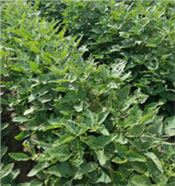Guess Who’s Back – Japanese Beetle Emergence Begins In Illinois

DR. NICK SEITER
URBANA, ILL.
We measured this soybean canopy and found it was at 16 percent defoliation due to insect feeding.
Japanese beetle emergence is beginning throughout Illinois. While they get a lot of attention every year, the real impact on corn and soybean yield is generally pretty minor. (If you have roses, sassafras trees, or a golf course, different story). A few things to keep in mind when you scout:
Check the field interior as well as the edges. It’s not uncommon to find higher numbers (and damage) at the edge of the field than the interior.
Soybean can take a lot of defoliation without sacrificing yield. Our action threshold prior to bloom is 30 percent defoliation; during the reproductive stages, it’s 20 percent. To put that in perspective, the image below shows a soybean canopy with around 16 perent defoliation.
A lot of Japanese beetle silk feeding occurs on brown silks. Silk clipping by Japanese beetle (or corn rootworm beetles) can interfere with pollination, but only if pollination is still ongoing and the silks are clipped to within ½ inch of the ear tip. The effect can be compounded by heat and drought stress. Scout for beetles clipping silks during pollination (especially the first 5 or so days of pollination), particularly if you’re experiencing drought at that time, but leave them alone once pollination is done. (You’re only getting revenge at that point).
Japanese beetle is one of our most recognizable pests, but economic damage to corn and soybean is relatively uncommon in Illinois. In those rare instances where it does reach damaging levels, several available insecticides provide effective control. For more details on this insect’s biology and damage potential, several of my colleagues wrote a full profile a few years ago (https://academ ic.oup.com/jipm/ article/10/1/9/5454734). ∆
DR. NICK SEITER: Field Crop Entomologist, University of Illinois